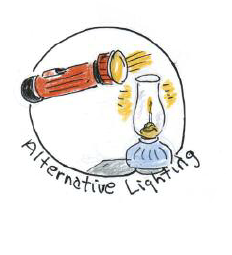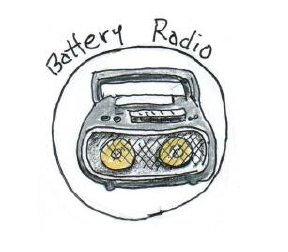This information is provided courtesy of the New York City Mayor’s Office for People with Disabilities.
Visual Disabilities
- If you use a cane, keep extras in strategic, consistent and secured locations at work, home, school, volunteer sites, etc. to help you maneuver around obstacles and hazards. Keep a spare cane in your emergency kit.
- If you have some vision, place security lights in each room to light paths of travel. These lights plug into electrical wall outlets and light up automatically if there is a loss of power. They will, depending on type, continue to operate for one to six hours and can be turned off manually to be used as a flashlight.

- Store high-powered flashlights (with wide beams) and extra batteries.
- If you wear soft contact lenses, plan to have an alternative available because you will not be able to operate the cleaning unit without power.
- Service animals may become confused, panicked, frightened or disoriented in and after a disaster. Keep them confined or securely leashed or harnessed. A leash (or harness) is an important item for managing a nervous or upset animal. Be prepared to use alternative methods to negotiate your environment.
- Plan on losing the auditory clues you normally rely on following a major disaster.
- If helpful, mark emergency supplies with large print, fluorescent tape or Braille.
Hearing Impairments
- Store extra batteries for hearing aids and implants. If available, keep an extra hearing aid with your emergency supplies.
- Store extra batteries for your TTY and light phone signaler. Check your manual for proper maintenance advice.
- Store hearing aids in a consistent, convenient and secured place, so you can quickly and easily locate them after a disaster. Consider storing them in a container attached to your night stand or bed post. Missing or damaged hearing aids may be difficult to replace or fix following a disaster.
- Install both audible alarms and visual smoke alarms. At least one should be battery-operated.
- Determine how you will communicate with emergency personnel if there is no interpreter or if you do not have your hearing aid(s). Store paper and pens.

- Consider carrying a pre-printed copy of key phrases, such as “I speak American Sign Language (ASL) and need an ASL interpreter.”
- If possible, obtain a battery-operated television that has a decoder chip for access to signed or captioned emergency reports.
- Determine which broadcasting systems will provide continuous news that will be captioned and/or signed.
Mobility Concerns
- Store emergency supplies in a small Go Bag attached to your walker, wheelchair or scooter.
- Store needed mobility aids (canes, crutches, walkers, wheelchairs) close to you in a consistent, convenient and secured location. Keep extra aids in several locations, if possible. Keep a pair of heavy gloves in your supply kit to use while wheeling or making your way over glass and debris.
- If you use a motorized wheelchair or scooter, contact your medical supply company for information regarding a back-up power source such as a battery.
- If you do not have puncture-proof tires, keep a patch kit or can of “seal-in-air” to repair flat tires and/or keep an extra supply of inner tubes.
- Store a lightweight, manual wheelchair if possible.
- Arrange and secure furniture and other items to create barrier-free passages in your home and office.
- If you live in an apartment and spend time above the first floor of an elevator building, plan and practice using alternate methods of evacuation. If needed, enlist the help of your personal support network.
- There will be instances where wheelchair users will have to leave their chairs behind in order to evacuate safely. If you cannot use stairs, familiarize yourself with lifting and carrying techniques that will work for you. Alert rescue personnel to any areas of vulnerability.
Life Support Systems
- Secure your life-support equipment to prevent damage from falling. If you use a chain, make sure it is welded (not bent).
- Determine which facilities/providers can serve you if your home system becomes inoperable or your current provider is unable to assist you.
- Ask your vendor about alternative power sources that will sustain you for up to seven days.
- Determine if you could you use manually-operated equipment.
- Find out if your equipment can be powered from a vehicle battery. If yes, obtain any hardware necessary for the hook-up and follow safety instructions.
- Ask your provider if a reduced-flow rate may be used during a disaster to prolong the life of the system. Record on your equipment the reduced-flow numbers so you can refer to them.
- Be aware of oxygen safety; avoid areas where gas leaks or open flames may be present.
- Post “Oxygen in Use” signs.
- Keep the shut-off switch for oxygen equipment near you so you can get to it quickly in an emergency.
- If your backup power system relies on batteries, be aware that stored batteries require periodic charging, even if they are unused. A charging routine must be strictly followed.
- Test your alternative power equipment regularly to ensure it will function in an emergency.
- Know the working duration of any batteries that support your system.
- Ask your power company about the type of backup power you plan to use and get their advice.
- Ask your utility company if the medical equipment you use qualifies you to be listed as a life- sustaining equipment customer. Never count on your power being quickly restored. Utility personnel may not be able to reach you right away after a major disaster.
- Show your personal support network how to operate and safely move your equipment if necessary.
- Label equipment and attach instruction cards (laminate them for added durability).
Communication Disabilities
- Determine how you will communicate with emergency personnel if you do not have your communication devices (augmentative communication device, word board, artificial larynx).
- Store paper, writing materials, copies of a word or letter board and pre-printed key phrases specific to anticipated emergencies in your emergency supply kit, your wallet/purse, and your Go Bag.
- Make sure your emergency health information card explains the best method of communication for you (written notes, pointing to letters/words/pictures, finding a quiet place).
- Obtain an alternative power source (power converter, batteries) if you use a computer or laptop as a means of frequent communication.
Cognitive Disabilities
- Practice what to do during and after specific disasters that occur in your area. Practice evacuating from places where you spend time (job, home, school, volunteer assignment) until you feel comfortable and confident that you will know what to do during and after an emergency.
- Keep a written emergency plan with you and in several locations. Make sure it is easy to read and understand.
- After a disaster, information often comes at you quickly. Think through ways to do things you will need to do after a disaster. Keep a list of tasks, a calendar with room for notes and a small tape recorder with you in order to help you remember things.
- Give copies of your written emergency plan to the people in your personal support network.
- Think about what a rescuer might need to know about you and be prepared to say it briefly, or keep a written copy with you. For example:
- “I communicate using an augmentative communication device. I can point to simple pictures or key words, which you will find in my wallet or emergency supply kit.”
- “I may have difficulty understanding what you are telling me, please speak slowly and use simple language.”
- “I forget easily. Please write down information for me.”
Environmental or Chemical Sensitivities
- Collect emergency supplies based on your worst days. Following a major disaster, an excess of smoke, dust, molds, gas leaks, diesel from idling rescue vehicles, flashing lights, radio waves, electromagnetic fields (from generators, emergency lights, cellular phones, walkie talkies) and airborne toxins may trigger stronger reactions than you normally experience.
- Consider adding the following to your emergency supply kit and Go Bag:
- Emergency health information card. This should clearly explain your sensitivities, reactions, most effective treatments, and treatments which are harmful to you. Be specific, as environmental illness is not commonly understood. Remember that some reactions (disorientation, aphasia, panic) may be diagnosed and treated as something other than chemical sensitivity and you may not be able to describe your needs verbally.
- Medications including inhalers, epinephrine shots and anticonvulsant.
- Prescriptions and treatment authorization requests from your doctor for unusual, orphan or hard-to-find medications.
- Supplements, herbs and homeopathic remedies.
- Charcoal mask and/or respirator.
- Well aired-out (outgassed) plastic or steel tubing and ceramic mask or outgassed plastic mask for oxygen.
- Rolls of aluminum foil for covering chairs, your sleeping area, food, etc.
- Baking soda, stored in a waterproof container (for washing).
- Know where the nearest safe places are, especially open air places.
- Avoid hermetically sealed shelters.
Psychiatric Disabilities
- Think through what a rescuer might need to know about you and practice saying it briefly, or keep a written copy on hand. For example:
- “I have a psychiatric disability and may become confused in an emergency. Help me find a quiet corner and I should be fine in approximately 10 minutes.”
- “I have a panic disorder. If I panic, give me (name of medication and dosage) located in my (purse, wallet, pocket).”
- “I take Lithium and my blood level needs to be checked every (hour, etc.).”
- There are a number of emotional reactions that may occur or become more severe after a disaster. These include confusion, memory and thought processing difficulties, agitation, paranoia, crying, fear, panic, sleep disturbance, pacing, shouting, depression, withdrawal, irritability, anxiety and shaking.
- Anticipate the types of reactions you may have and plan strategies for coping with them.
- Consider seeking input from your friends, family, therapist or service provider(s).
- Be prepared to have members of your personal support network offer emotional support so you can acknowledge and express feelings.
- You may need medical assistance or even be hospitalized.
- Keep a copy of your emergency health information card with you, as well as a copy of a durable power of attorney for health so that someone you have chosen may intervene for you.


